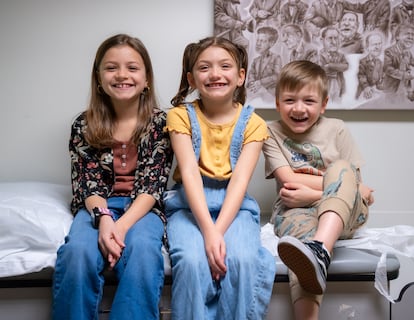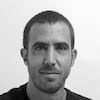A Spanish therapy saves the lives of ‘the unluckiest family in the world’
Three American siblings and six other children born with a rare, life-threatening disease are returning to normal life thanks to a genetic treatment developed in Madrid

Five years ago, kindergarten teacher Alicia Langenhop felt that hers was “the unluckiest family in the world.” She and her husband, unknowingly, were carriers of a rare DNA mutation that, if inherited from both parents at the same time, causes a potentially fatal disease that affects only one in every million people worldwide. They didn’t know it yet, but each child they conceived would have a 25% chance of suffering from the disease. They had three children, and all three suffered from the genetic disorder, which nullified their defenses and condemned them to constant infections.
The probability of such a thing happening was similar to receiving a specific coin out of hundreds of thousands, flipping it six times, and always landing on tails. A Spanish therapy has now allowed the three siblings — Ava, 9; Olivia, 7; and Landon, 5 — and six other children to return to their normal lives. The astonishing results were published on April 30 in The New England Journal of Medicine.
The story began about 15 years ago, in a laboratory in Madrid at the Center for Energy, Environmental and Technological Research (CIEMAT). A team led by Juan Antonio Bueren and Elena Almarza decided to tackle an extremely rare disease, leukocyte adhesion deficiency type 1 (LAD-1), which causes children to suffer extremely painful bacterial infections, with ulcers on the skin, mouth, and respiratory tract, because their white blood cells are abnormal and unable to fight off invading microbes.
“Seventy percent of patients with severe LAD-I die before reaching the age of three,” Bueren laments. The disease is caused by a gene mutation that results in the absence of a protein essential for white blood cells to travel from the blood to infected tissues. In 2016, the Madrid team managed to cure the disorder in mice, using a genetically modified virus to introduce the correct version of the defective gene into the cells. Immediately afterward, the U.S. company Rocket Pharma, headquartered in the Empire State Building in New York, purchased the rights to the therapeutic strategy.
The new study details the first results in humans. Nine children have had stem cells, precursors to white blood cells, extracted from their bone marrow. The therapeutic gene was inserted in the laboratory and the corrected cells returned to the body. “They are all in school, leading normal lives. From a clinical perspective, they are doing wonderfully,” celebrates Bueren, former president of the European Society for Gene and Cell Therapy.
The clinical trial, funded by Rocket Pharma, was conducted with a Turkish child at the Niño Jesús Hospital in Madrid, six other participants at the University of California, Los Angeles, and two more at University College London. Dr. Julián Sevilla, who is in charge of the patient in Spain, believes that it might be said that the patients are cured. “The nine children have done phenomenally well, but ours, in particular, has done spectacularly; she has had absolutely no complications. She is perfectly fine. With this clinical trial, we have demonstrated that the treatment is curative,” he says. The team had already achieved similar success in December in another trial for Fanconi anemia, a genetic disease that also affects children.
The therapy is designed to be applied one day and last a lifetime, as the modified cells produce healthy white blood cells. The results now published detail the children’s follow-up over two years, with no recurrence of symptoms. How long must pass before it can be stated that this is curative and that they won’t lose those corrected cells? “There’s no estimate, but what we have to consider is that they don’t have to lose them. It’s the same as when you do a [bone marrow] transplant and you assume the donor’s cells will be there for life. This is the same. The cells have been corrected, and there’s no reason to assume the graft will be lost at some point, because they’ve been there for more than two years and have functioned perfectly,” explains Sevilla, head of Hematology at the Niño Jesús Hospital.

The biochemist Elena Almarza left CIEMAT, a public center affiliated with the Ministry of Science, in 2020 to join Rocket Pharma’s new facilities in Madrid’s Science Park. On social media, she has celebrated “the lives of nine children saved.” If, as is likely given the lack of alternatives, regulatory agencies authorize the treatment, the big question mark will be the price tag. Viruses from the lentivirus family, like those used in this new therapy, have already proven to be a potential cure for around 15 rare genetic diseases, whether affecting the immune system, red blood cells, or metabolic disorders. They are some of the most expensive medicines in the world.
Bueren explains that “the cost of analogue treatments is over two million euros per patient and, in some cases, reaches five million.” The European Society for Gene and Cell Therapy, he states, is fighting for public institutions to develop these types of treatments on a non-profit basis, with the goal of making their prices “much more accessible” to national health systems. These are sophisticated therapies tailored to each individual, extremely expensive because they require genuine biological craftsmanship and months of laboratory work, but also because pharmaceutical company shareholders want to maximize their profits. Rocket Pharma, with investments of around €330 million ($374 million), is listed on the Nasdaq stock exchange.
The Niño Jesús Hospital protects its patient’s privacy, but the University of California, Los Angeles, has been providing a step-by-step account of the treatment of the three Langenhop siblings, whom the U.S. institution itself described as “the unluckiest family in the whole entire world.” Alicia Langenhop’s account is moving. “We felt like we had to climb a mountain every day. Every fever, every rash, was terrifying. We were always thinking the worst,” the mother recalls in a statement.
The three American children no longer need to constantly visit the emergency room to treat their ulcers, but are leading completely normal lives thanks to a therapy developed in Madrid. Juan Antonio Bueren is optimistic but cautious: “Everything indicates that this treatment will be definitive, but we cannot definitively say that the patients are cured; that will take longer.”
Sign up for our weekly newsletter to get more English-language news coverage from EL PAÍS USA Edition
Tu suscripción se está usando en otro dispositivo
¿Quieres añadir otro usuario a tu suscripción?
Si continúas leyendo en este dispositivo, no se podrá leer en el otro.
FlechaTu suscripción se está usando en otro dispositivo y solo puedes acceder a EL PAÍS desde un dispositivo a la vez.
Si quieres compartir tu cuenta, cambia tu suscripción a la modalidad Premium, así podrás añadir otro usuario. Cada uno accederá con su propia cuenta de email, lo que os permitirá personalizar vuestra experiencia en EL PAÍS.
¿Tienes una suscripción de empresa? Accede aquí para contratar más cuentas.
En el caso de no saber quién está usando tu cuenta, te recomendamos cambiar tu contraseña aquí.
Si decides continuar compartiendo tu cuenta, este mensaje se mostrará en tu dispositivo y en el de la otra persona que está usando tu cuenta de forma indefinida, afectando a tu experiencia de lectura. Puedes consultar aquí los términos y condiciones de la suscripción digital.
More information

A devastating nerve disease stalks a mountain village
Archived In
Últimas noticias
All the effects of gentrification in one corner of Mexico’s Colonia Roma
Palestinian reporter Youmna El Sayed: ‘My family told me I had to choose between being a journalist or a mother’
The new language of the workplace: Knowing how to ask AI questions is more important than using it
‘Sleepless City’: The light of cinema illuminates Madrid’s Cañada Real shantytown
Most viewed
- Families demand repatriation of bodies of Colombians who died in Ukraine: ‘This war is a slaughterhouse for foreigners’
- The low-cost creative revolution: How technology is making art accessible to everyone
- Liset Menéndez de la Prida, neuroscientist: ‘It’s not normal to constantly seek pleasure; it’s important to be bored, to be calm’
- Christian Louboutin: ‘Young people don’t want to be like their parents. And if their parents wear sneakers, they’re going to look for something else’
- ‘El Limones’ and the growing union disguise of Mexican organized crime










































